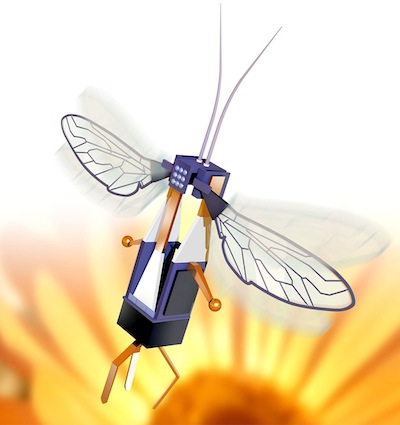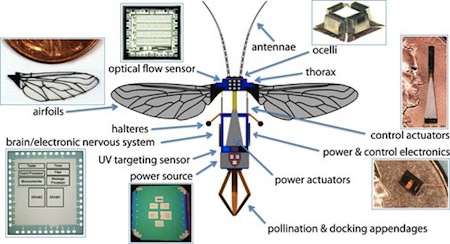Science Fiction
Dictionary
A B C D E F G H I J K L M N O P Q R S T U V W X Y Z
Robobees To Swarm At Harvard

Robobee is the latest buzzword at Harvard University and Northeastern University, which received a $10 million grant to create a swarm of robotic bees. Based on news reports, it appears that researchers are attempting to build an entirely mechanical flying insect. (As opposed to cyborg insects like the HI-MEMS cyborg beetle.)

(Robobee from teh robobee homepage)
According to news reports, the work will likely be based on the earlier research of Professor Robert Wood, whose team created a robotic fly micro air vehicle that made quite a stir in 2007. The robotic fly weighs just sixty milligrams and has a wingspan of just three centimeters.
Bees and bee colonies have long been held up as models of efficiency and coordination. Using a host of different sensors, unique communication protocols, and a precise hierarchy of task delegation, thousands of bees can work independently on different tasks while all working toward a common goal--keeping their colony alive. Researchers in this Expedition will create robotic bees that fly autonomously and coordinate activities amongst themselves and the hive, much like real bees.

(Robobee diagram)
The research team aims to drive research in compact high-energy power sources, ultra-low-power computing, and the design of distributed algorithms for multi-agent systems. Furthermore, the RoboBees created will provide unique insights into how Mother Nature conjures such elegant solutions to solve complex problems.
Take a look at this unique video of the robotic fly taking its rightful place in the Museum of Modern Art.
(robotic flies in MOMA video)
Science fiction fans should be happy about this; purely robotic insects have been taken seriously by science fiction writers for almost three-quarters of a century. Technovelgy readers are of course familiar with the amazing scarab robot flying insect from Raymond Z. Gallun's 1936 story The Scarab:
The Scarab paused on its perch for a moment, as if to determine for itself whether it was perfectly fit for action. It was a tiny thing, scarcely more than an inch and a half in length......the Scarab buzzed into the great workroom as any intruding insect might, and sought the security of a shadowed corner. There it studied its surroundings, transmitting to its manipulator, far away now, all that it heard through its ear microphones and saw with its minute vision tubes.
Read more at the Harvard Robobees homepage and the NSF press release; via ComputerWorld.
Scroll down for more stories in the same category. (Story submitted 10/9/2009)
Follow this kind of news @Technovelgy.| Email | RSS | Blog It | Stumble | del.icio.us | Digg | Reddit |
Would
you like to contribute a story tip?
It's easy:
Get the URL of the story, and the related sf author, and add
it here.
Comment/Join discussion ( 2 )
Related News Stories - (" Robotics ")
Artificial Skin For Robots Is Coming Right Along
'... an elastic, tinted material that had all the feel and appearance of human flesh and epidermis.' - Harl Vincent (1934)
Robot Guard Dog On Duty
I might also be thinking of K-9 from Doctor Who.
Wearable Artificial Fabric Muscles
'It is remarkable that the long leverages of their machines are in most cases actuated by a sort of sham musculature...' HG Wells, 1898.
Dancing Robots Taught Dance Moves
'A clockwork figure would be the thing for you...' Jerome K. Jerome, 1893.
Technovelgy (that's tech-novel-gee!) is devoted to the creative science inventions and ideas of sf authors. Look for the Invention Category that interests you, the Glossary, the Invention Timeline, or see what's New.
Science Fiction
Timeline
1600-1899
1900-1939
1940's 1950's
1960's 1970's
1980's 1990's
2000's 2010's
Current News
The Zapata Air Scooter Would Be Great In A Science Fiction Story
'Betty's slapdash style.'
Thermostabilized Wet Meat Product (NASA Prototype)
There are no orbiting Michelin stars. Yet.
Could Crystal Batteries Generate Power For Centuries?
'Power could be compressed thus into an inch-square cube of what looked like blue-white ice'
India Ponders Always-On Smartphone Location Tracking
'It is necessary... for your own protection.'
Amazon Will Send You Heinlein's Knockdown Cabin
'It's so light that you can set it up in five minutes by yourself...'
Is It Time To Forbid Human Driving?
'Heavy penalties... were to be applied to any one found driving manually-controlled machines.'
Replace The Smartphone With A Connected Edge Node For AI Inference
'Buy a Little Dingbat... electropen, wrist watch, pocketphone, pocket radio, billfold ... all in one.'
Artificial Skin For Robots Is Coming Right Along
'... an elastic, tinted material that had all the feel and appearance of human flesh and epidermis.'
Robot Guard Dog On Duty
I might also be thinking of K-9 from Doctor Who.
Wearable Artificial Fabric Muscles
'It is remarkable that the long leverages of their machines are in most cases actuated by a sort of sham musculature...'
BrainBridge Concept Transplant Of Human Head Proposed
'Briquet’s head seemed to think that to find and attach a new body to her head was as easy as to fit and sew a new dress.'
Google's Nano Banana Pro Presents Handwritten Math Solutions
'...copy was turned out in a charming and entirely feminine handwriting.'
Edible Meat-Like Fungus Like Barbara Hambly's Slunch?
'It was almost unheard of for slunch to spread that fast...'
Sunday Robotics 'Memo' Bot Has Unique Training Glove
'He then started hand movements of definite pattern...'
Woman Marries Computer, Vonnegut's Dream Comes True
'Men are made of protoplasm... Lasts forever.'
Natural Gait With Prosthetic Connected To Nervous System
'The leg was to function, in a way, as a servo-mechanism operated by Larry’s brain...'
